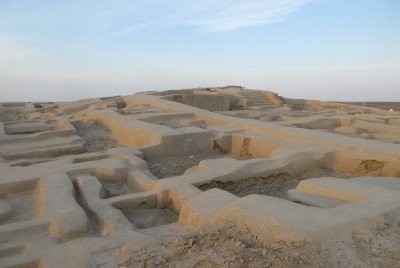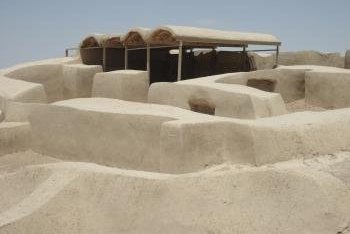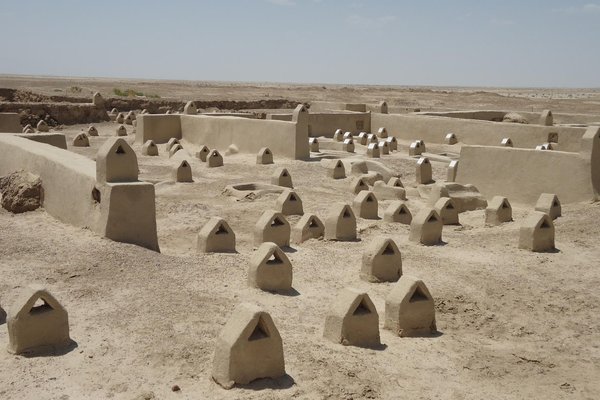Iran
Shahr-i Sokhta
Shahr-i Sokhta is the archaeological site of a Bronze Age urban settlement.
This mud brick city was one of the first complex societies in the region and an example of early urban planning. The remains of a monumental area, residential areas, metal workshops and a graveyard have been preserved due to the desert climate. The city appeared around 3200 BCE, was burnt down several times and finally was abandoned in 1800 BCE after changes in water courses.
Community Perspective: Located in the far east of Iran, near the Pakistani border, this site isn’t often visited. Jarek did so in 2010 and gave tips for visiting on public transport. Wojciech drove there very swiftly in 2018 and found it a pretty drive through the Lut Desert. They agree on “take plenty of water as there is no shadow at all”.
Site Info
Official Information
- Full Name
- Shahr-i Sokhta (ID: 1456)
- Country
- Iran
- Status
-
Inscribed 2014
Site history
History of Shahr-i Sokhta
- 2014: Advisory Body overruled
- ICOMOS proposed Deferral, Malaysia & Lebanon provided Amendments to Inscribe
- 2014: Inscribed
- Inscribed
- Type
- Cultural
- Criteria
- ii
- iii
- iv
Links
- UNESCO
- whc.unesco.org
- Official
-
- visitiran.ir — Visit Iran
- Related
-
- archive.archaeology.org — The graveyard of Shahr-i Sokhta (1975 article)
- 2010-q-conference.com — Gunnar Heinsohn: Thrice Burnt - Shahr-i Sokhte
All Links
UNESCO.org
- whc.unesco.org — whc.unesco.org/
Official Website
- visitiran.ir — Visit Iran
Related Resources
- archive.archaeology.org — The graveyard of Shahr-i Sokhta (1975 article)
- 2010-q-conference.com — Gunnar Heinsohn: Thrice Burnt - Shahr-i Sokhte
News Article
- May 14, 2015 presstv.ir — Archaeologists find tallest wall ever found near Iran’s Burnt City
- Jan. 16, 2015 newhistorian.com — Ancient Piece of Leather Found in Burnt City
- July 23, 2014 tehrantimes.com — Archaeologists find bizarre burials in Burnt City
Community Information
- Community Category
- Archaeological site: Near Eastern
Travel Information
Red Zone Travel Advisory
Recent Connections
-
Historic climate change
"Changes in water courses and climate c…
-
Red Zone Travel Advisory
Iran fully off-limits -
Proto-cities
"Shahr-i Sokhta displays an exceptional…
Connections of Shahr-i Sokhta
- Individual People
-
-
Aurel Stein
The site was discovered and investigated by Aurel Stein in the early 1900s. (wiki)
-
- Trivia
-
-
Role of Women
A number of 5,000-year-old insignias, which were found in the graves of some female inhabitants, suggest that the women of the city enjoyed social and financial prominence.
-
- History
-
-
Oldest Buildings
- 3200-1800 BC "Founded around 3200 BC, it was populated during four main periods up to 1800 BC, during which time there developed several distinct areas within the city: those where monuments were built, and separate quarters for housing, burial and manufacture." -
Historic climate change
"Changes in water courses and climate change led to the eventual abandonment of the city in the early second millennium." (OUV statement)
-
Historical Food Remains
During these investigations several categories of botanical remains such as cereals (grains and legumes),fruits, spices and wood were studied. (Nom File) -
Bronze Age
Located at the junction of Bronze Age trade routes (AB ev) -
Proto-cities
"Shahr-i Sokhta displays an exceptional and even unique testimony to the development of a human settlement in a specific geographical location during the Bronze Age in the eastern part of the Iranian Plateau. For more than a thousand years, from 3200 BCE to c. 2000 BCE, the proto-urban site of Shahr-i Sokhta was the capital of a region ranging from Kandahar to Makran shores" (nom file)
-
- Architecture
-
-
Vernacular architecture
mud brick architecture (AB ev) -
Brick architecture
mudbrick city
-
- Human Activity
-
-
Irrigation and drainage
sewage system -
Ancient Board Games
The oldest discovered backgammon
-
- Constructions
-
-
Cemeteries
The graveyard located at the south and south-western part of the site contains 20,000-37,000 graves (AB ev)
-
- Timeline
-
-
Built in the 4th millennium BC
The settlement of Shahr-i Sokhta was founded c. 3200 BCE (AB ev)
-
- Visiting conditions
-
-
Red Zone Travel Advisory
Iran fully off-limits
-
News
- presstv.ir 05/14/2015
- Archaeologists find tallest wall e…
- newhistorian.com 01/16/2015
- Ancient Piece of Leather Found in …
- tehrantimes.com 07/23/2014
- Archaeologists find bizarre burial…
Recent Visitors
- Harry Mitsidis
- Roman Bruehwiler
- Zoë Sheng
- Afshin Iranpour
- Wojciech Fedoruk
- Jarek Pokrzywnicki
- Thomas Buechler
Visitors of Shahr-i Sokhta
Community Reviews
Show full reviews
'There lies madness when chasing WHS' – wrote Solivagant about the idea of going from Kaluts to Shahr-i Sokhta through all Lut Desert. These words resonated with me as we decided to take this trip. It is 'only' 450 kilometers away and my GPS showed it could take around 6 hours. In fact it took a lot less – maybe 4 hours or so – I drove up to 150kmph through abandoned desert, on a good road, seeing other cars maybe once per 15 minutes. Remember to have enough gas, although there were some gas stations on the way. The landscapes on the way were just great and far different from nebkas near Shahdad and Kaluts. This road is the best way to enjoy Lut Desert and discover its marvels.
So as a result it was not that mad to go to Shahr-i Sokhta (believe me, there is much more madness in going to isolated Gonbad-e Qabus from Tehran). We were there at around 3 pm and the staff looked like we were the only foreign tourists this month (they certainly do not see many European families with two small children in Baluchistan and Sistan, the remotest Iranian province)... They let us go without any entrance fee, but the guard accompanied us all the time we visited this site. And the site is very huge, if you want to walk all the paths, reserve at least two hours, maybe even more (we did quicker route which took us almost …
Keep reading 0 comments
Site visited in May 2010. Sharhr-i Sokhta or Shahr-e Sūkhté (farsi name means exactly Burnt City in English) is located between Zabol and Zahedan (Iranian towns that are located close to Pakistan border, around 177 km from Zahedan and ca 55 from Zabol). In theory there is a convenient public transport from Zahedan (oficial taxi from Zahedan Bus Station to Zabol, a place in a car should cost around 5 Euro per person, one way). It is also possible to hire a taxi on your own for the whole trip (dar baste) - including waiting time - prices are negotiable.
The site consists of two parts: main excavations area covering around 150 ha - vast land where only 3 % of the ancient city is uncovered and prepared for visiting. Second part is a small museum located on the opposite side of the road, some 900 meters from the exavations entrance.
It is good to start visiting the site from small Visitors Centre (all the information, photos and maps are displayed in Farsi and English). Excavation site is serviced by circular hiking path covering all attractions (building sites, so called temples, craftsmen area, graveyards). Have in mind that currently it is almost a desert, no trees, no shadow so take plenty of water if you want to wander around.
The museum is relatively small but at least is under roof. The site itself is not very popular along Zahedan people but taxi drivers know the place.
…
Keep reading 0 comments
